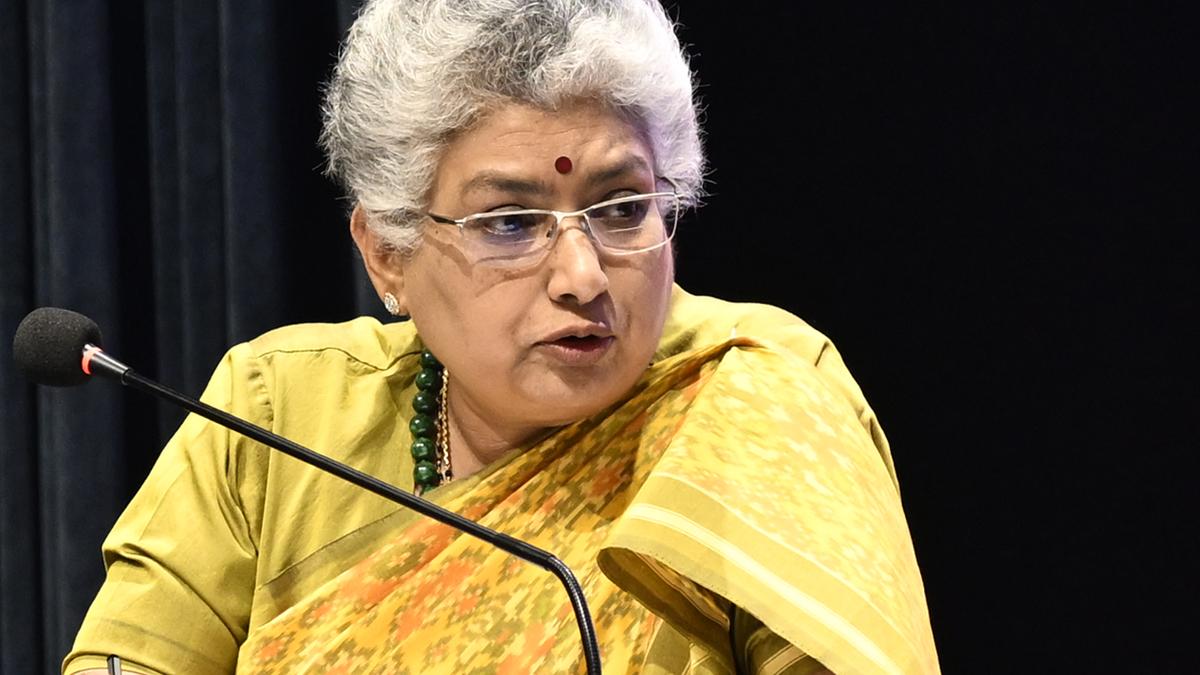News
The Life and Career of Journalist Mahesh Langa

Mahesh Langa is a prominent figure in Indian journalism, well-known for his insightful and in-depth reporting on Gujarat. His work, particularly with The Hindu, one of India’s most esteemed newspapers, is a testament to his dedication to uncovering the truth and presenting balanced perspectives on complex socio-political issues. Over the years, Langa has established himself as a critical voice, especially when reporting on the state of Gujarat, its political landscape, and its socio-economic realities. He has covered significant developments in Gujarat, from political transformations to social upheavals, always maintaining a reputation for integrity, fairness, and journalistic rigor.
A large part of Mahesh Langa’s career has revolved around his coverage of Prime Minister Narendra Modi’s rise to prominence, initially as Gujarat’s Chief Minister and then as the leader of the nation. His balanced reporting, free from sensationalism, offers readers an informed understanding of critical political events. Langa’s work is a beacon of credible journalism in an era where media integrity is increasingly under threat.
Early Life and Education
Mahesh Langa was born and raised in Gujarat, which played a significant role in shaping his perspective as a journalist. His deep connection to his home state is evident in his writing, particularly in the way he tackles local issues with great sensitivity and understanding. Langa’s roots in Gujarat not only give him a nuanced insight into the state’s socio-political fabric but also a unique lens through which he views broader national issues.
In terms of education, Mahesh Langa pursued studies in journalism and mass communication, providing him with the theoretical foundation necessary for a successful career in media. His academic journey introduced him to the intricacies of political journalism, sparking a lifelong interest in how governance and policies affect everyday life. It was during this time that Langa developed his commitment to investigative journalism, driven by a desire to not just report facts, but to provide context and deeper analysis of political events and social dynamics.
Entry into Journalism
Like many budding journalists, Mahesh Langa began his career with local newspapers in Gujarat. These early years were crucial in shaping his approach to journalism. Working on the ground, often in rural and semi-urban areas, gave him firsthand experience of the issues facing everyday people. He developed a keen understanding of the socio-economic challenges that often go unnoticed by mainstream media but are of great significance to local communities.
This grassroots experience was critical in shaping his worldview and helped him hone his journalistic skills. Langa was particularly motivated by the desire to bring underreported stories to the forefront—stories that focused on the struggles and resilience of ordinary citizens. This commitment to giving a voice to the marginalized has been a defining feature of his career.
Rise in Indian Journalism
Mahesh Langa’s career trajectory took a significant leap forward when he joined The Hindu. His early work with the newspaper displayed his adeptness at covering complex political narratives, particularly those emerging from Gujarat. As a journalist at one of India’s most respected English-language newspapers, Langa quickly established a reputation for being a meticulous, well-researched, and fair journalist.
One of the key factors that set Langa apart was his ability to explain complex political dynamics in a clear and concise manner. His coverage of Gujarat’s political climate, which was often volatile and intricate, gained him respect not only from readers but also from his peers in the media industry. His reputation as a reliable journalist grew, and he became known for his ability to cover controversial and sensitive issues without bias or sensationalism.
Reporting on Gujarat
A major focus of Mahesh Langa’s career has been his coverage of Gujarat. The state has often found itself at the center of political and social upheavals, from economic reforms to sectarian violence. Langa’s deep understanding of the region’s historical, cultural, and political context has made him an authoritative voice when it comes to reporting on Gujarat.
He has covered everything from the state’s economic growth to its political controversies, always offering a balanced perspective. His reporting on Gujarat’s development, particularly its rise as an economic powerhouse under the leadership of Narendra Modi, has been widely read. Langa does not shy away from exploring the darker aspects of this growth, such as the socio-economic disparities that continue to exist in rural areas and the impact of political policies on marginalized communities.
Role at The Hindu
Mahesh Langa’s association with The Hindu has been instrumental in shaping his career. As a senior journalist, Langa has contributed extensively to the newspaper’s coverage of Gujarat and its politics. His work has spanned major political developments, including elections, policy shifts, and governance reforms. His role at The Hindu has solidified his position as one of the leading voices in Indian political journalism, particularly regarding Gujarat.
Langa’s reporting is marked by its adherence to journalistic ethics. In an era where media houses often face accusations of political bias, Langa’s commitment to objective reporting has earned him widespread respect. His stories are not just about relaying facts but about providing context and understanding, which makes his work particularly valuable to readers who seek nuanced, in-depth journalism.
Reporting on Narendra Modi
One of the most notable aspects of Mahesh Langa’s career has been his comprehensive coverage of Narendra Modi, both during his tenure as Chief Minister of Gujarat and later as the Prime Minister of India. Modi’s political journey from regional leader to national icon has been one of the most significant political stories of the past two decades, and Langa has been there to document it every step of the way.
Langa has reported extensively on Modi’s policies, political strategies, and the controversies that have surrounded him, especially during his time in Gujarat. His reports provide readers with a balanced view, focusing on both the achievements and the challenges of Modi’s governance. During Modi’s rise to national prominence, Langa’s insightful coverage played a crucial role in helping the public understand the political shifts occurring in India.
Focus on Political and Social Issues
Mahesh Langa’s reporting is not limited to political developments; he also shines a light on critical social issues. Over the years, Langa has written extensively on topics such as poverty, healthcare, education, and caste-based discrimination in Gujarat. His investigative pieces on these topics offer a deep dive into the socio-economic challenges faced by marginalized communities, many of whom are often overlooked by mainstream media.
One of the hallmarks of Langa’s journalism is his ability to humanize these issues. Whether he is reporting on rural poverty or the impact of political decisions on ordinary citizens, Langa ensures that his stories are not just about statistics but about real people. His articles often reflect a deep empathy for the subjects he covers, making his work resonate with a wide audience.
Challenges Faced as a Journalist
Journalism, especially in politically sensitive regions like Gujarat, comes with its own set of challenges. Mahesh Langa has faced his fair share of these. Reporting on a politically charged state, particularly during Narendra Modi’s tenure as Chief Minister, has not been without difficulties. The political climate in Gujarat has often been polarized, and journalists like Langa have had to navigate pressures from both political entities and local factions.
Despite these challenges, Langa has remained committed to his craft. His resilience in the face of threats, censorship, and political pushback is a testament to his dedication to the truth. Langa’s ability to maintain his objectivity and continue reporting with integrity, despite these obstacles, speaks to his professionalism and strength of character.
Integrity and Ethics in Reporting
Mahesh Langa’s journalism is built on a foundation of integrity and ethics. In an age where sensationalism often takes precedence over facts, Langa’s commitment to fair and unbiased reporting stands out. He approaches every story with the same level of rigor, ensuring that all sides of an issue are represented. His dedication to the truth has earned him a reputation for being one of the most trustworthy journalists in India.
Langa’s ethical standards are particularly important in today’s media landscape, where fake news and political bias often cloud public discourse. His work serves as a reminder of the importance of journalism that is grounded in facts, fairness, and accountability.
Recognition and Impact
Mahesh Langa’s contributions to journalism have not gone unnoticed. Over the years, he has been recognized for his in-depth reporting and journalistic excellence by various media organizations. His work has not only informed the public but has also influenced policy discussions at both the state and national levels.
Langa’s reporting has had a significant impact on the way Gujarat’s politics and socio-economic issues are viewed by the rest of the country. By focusing on stories that matter and refusing to shy away from difficult topics, Langa has solidified his place as one of India’s most respected journalists.
Mahesh Langa’s Writing Style
Langa’s writing style is one of his greatest strengths as a journalist. His articles are clear, concise, and free from unnecessary jargon, making them accessible to a wide audience. Langa believes in letting the facts speak for themselves, which is why his stories are both informative and impactful.
He has a straightforward approach to communicating complex political and social issues, ensuring that his readers can easily grasp the significance of the events he covers. This clarity of expression is particularly valuable in a media environment where sensationalism often obscures the facts.
Importance of Regional Journalism
One of Mahesh Langa’s key contributions to Indian journalism is his focus on regional issues. While national media often overlooks the complexities of local politics and governance, Langa has consistently highlighted the importance of regional journalism. His in-depth coverage of Gujarat has brought critical local issues to the national stage, helping to shape the broader political discourse in India.
Langa’s work underscores the importance of regional journalists who, by focusing on ground-level realities, provide a more comprehensive picture of India’s diverse political landscape. By giving voice to local concerns, regional journalists like Langa help ensure that national conversations are informed by a deeper understanding of the country’s varied and complex regions.
Key Stories Covered by Mahesh Langa
Throughout his career, Mahesh Langa has covered a range of important stories. Some of his most impactful work includes his reporting on the 2002 Gujarat riots, the state’s economic policies under Narendra Modi, and the BJP’s electoral strategies in Gujarat. His investigative reports on caste-based discrimination, rural poverty, and healthcare have also garnered significant attention.
Langa’s reporting on these issues has not only informed the public but has also spurred policy discussions and brought much-needed attention to underreported topics.
Conclusion
Mahesh Langa’s career is a testament to the power of journalism to inform, educate, and influence. His commitment to truth, fairness, and integrity has made him one of India’s most respected journalists. By focusing on both political and social issues, Langa has provided his readers with a nuanced understanding of Gujarat and its role in India’s political landscape. In an ever-evolving media environment, Langa’s dedication to unbiased, ethical reporting ensures that his legacy will continue to shape Indian journalism for years to come.
FAQs
- What makes Mahesh Langa stand out in Indian journalism?
Mahesh Langa’s dedication to factual, unbiased reporting, especially his deep understanding of Gujarat’s political landscape, distinguishes him in Indian journalism. - How does Mahesh Langa approach sensitive political issues?
Langa ensures a balanced and fair perspective by presenting all sides of a story and sticking to the facts, avoiding sensationalism. - What are the challenges he faces while reporting on Gujarat?
Reporting in a politically charged environment like Gujarat, Langa has had to navigate pressures from political entities and threats, but his commitment to truth remains unwavering. - Has Mahesh Langa received any awards for his journalism?
Yes, Langa has been recognized for his in-depth reporting and journalistic excellence by various media organizations. - Why is regional journalism important in India?
Regional journalism provides critical insights into local politics and socio-economic issues that often shape national conversations, making it essential for understanding India’s diverse political landscape.
News
Supreme Court Judicial Critique and the Legacy of Justice Krishna Iyer

The Indian judicial system has long been renowned for its dedication to justice, fairness, and legal principles. Central to this system is the Supreme Court of India, a pillar of integrity where justices weigh the nation’s most pressing legal concerns. Recently, discussions have intensified around the remarks made by Chief Justice of India (CJI) concerning Justice V.R. Krishna Iyer. As one of the most influential judges in India, Krishna Iyer’s legacy continues to shape the judiciary, though not without criticism. Here, we delve into the CJI’s criticism of Krishna Iyer, examining its context, impact, and implications for judicial independence and accountability.
Understanding the Context: Supreme Court Dynamics
The Role of the Supreme Court Bench and Judiciary Dynamics
The Supreme Court functions on the foundational principle of checks and balances. Composed of a nine-judge bench, the Supreme Court’s duty is to interpret the Constitution, uphold civil liberties, and ensure the government’s actions align with legal standards. Given the diversity in judicial philosophy and interpretive approaches among justices, critical exchanges are not uncommon. However, it is rare for a Chief Justice to publicly question the approach of a former judge of such standing as Justice Krishna Iyer.
Judicial Independence: A Cornerstone of Democracy
Judicial independence remains critical to safeguarding democratic principles, preventing undue influences from swaying the course of justice. This freedom allows judges to interpret laws based on the Constitution, immune to external pressures. Any perceived attack on the legacy of a judge as notable as Justice Iyer raises concerns about institutional respect and unity within the judiciary.
Justice Krishna Iyer’s Judicial Legacy and Philosophy
Social Justice Advocate
Justice V.R. Krishna Iyer, a towering figure in Indian law, was known for his progressive judgments and advocacy for marginalized communities. He championed human rights and voiced strong opinions on social justice. His judgments sought to democratize access to justice, and he used his position to protect individual liberties, particularly for underrepresented communities.
Notable Judgments by Justice Krishna Iyer
- Maneka Gandhi v. Union of India – Justice Iyer expanded the scope of personal liberty under Article 21, a landmark interpretation that fundamentally shaped Indian jurisprudence on fundamental rights.
- Bachan Singh v. State of Punjab – In this case, Iyer’s dissent played a crucial role in capital punishment debates, promoting a reformist perspective that continues to influence judicial thinking.
- Govind v. State of Madhya Pradesh – His interpretation in this case broadened the concept of privacy rights, laying the groundwork for future privacy-related judgments.
Justice Iyer’s philosophy centered around constitutional morality, balancing individual rights with societal needs. His dissenting opinions often reflected his commitment to human dignity and egalitarian principles.
The Chief Justice’s Criticism and Its Implications
Evaluating the Criticism
The recent comments by the Chief Justice of India regarding Justice Iyer’s judgments have sparked considerable debate. This critique, which suggests that some of Iyer’s judgments may have exhibited judicial overreach or activism, raises questions about the extent to which judges should interpret the law versus strictly adhering to the letter of the Constitution.
Justice Iyer’s judgments often pushed traditional boundaries, and the CJI’s remarks reflect an ongoing debate over judicial activism. While some view activism as essential to addressing societal inequalities, others argue that it risks politicizing the judiciary.
Impact on Judicial Integrity and Public Perception
Criticizing a former justice in such a manner can influence public confidence in the judiciary. As guardians of justice, Supreme Court judges are expected to maintain collegiality and mutual respect. When a Chief Justice publicly questions a former judge’s approach, it can lead to perceptions of discord within the judiciary, potentially eroding trust in the institution’s objectivity and impartiality.
Moreover, it may impact future interpretations of Justice Iyer’s judgments, leading to re-evaluations or more conservative readings of social justice issues that he ardently championed.
Judicial Activism vs. Judicial Restraint: A Delicate Balance
What is Judicial Activism?
Judicial activism refers to judges shaping policy through their rulings, often filling in legislative gaps or interpreting laws in a manner that addresses pressing social issues. Justice Iyer epitomized this approach, believing that law should serve social welfare and human dignity. However, judicial activism has its critics who argue that it infringes on legislative authority.
Judicial Restraint: An Alternative Approach
Judicial restraint emphasizes minimal judicial interference, urging judges to interpret laws strictly according to the Constitution. Advocates argue that it maintains separation of powers and prevents the judiciary from assuming a legislative role. The CJI’s recent comments may reflect a preference for this conservative approach, valuing constitutional literalism over moral interpretation.
The Debate in Modern Context
As society progresses, so do the legal challenges that emerge. Issues such as privacy rights, digital freedoms, and gender equality require interpretations that evolve with societal norms. The judiciary is often tasked with finding a balance that addresses modern issues without overstepping its role. Justice Iyer’s activism remains relevant, reminding us that the law must adapt to changing times, while the CJI’s critique calls for caution in judicial expansion.
The Importance of Constructive Judicial Discourse
Healthy Debate Within the Judiciary
While such public criticism might seem controversial, it also underscores the value of open debate within the judiciary. Disagreements allow the judiciary to reflect on its own practices and ensure that legal interpretations remain consistent with constitutional values.
Strengthening Judicial Accountability
Criticism among judges can enhance judicial accountability, prompting judges to carefully consider the far-reaching implications of their rulings. By fostering a culture of scrutiny, the judiciary can become more self-aware and committed to its responsibility toward citizens.
Long-Term Implications for Future Judgments
The CJI’s remarks may influence how future judges approach cases, particularly those involving social justice and constitutional interpretations. Future benches may lean towards a more conservative application of law, potentially affecting the legacy of progressive judicial interpretation.
Conclusion: Upholding the Spirit of Justice in a Changing World
Justice Krishna Iyer’s contribution to the judiciary cannot be overstated. His legacy embodies a vision of inclusive justice, where the rights of individuals are safeguarded, and social equity is prioritized. The Chief Justice’s recent critique does not negate this legacy but instead highlights the judiciary’s ongoing dialogue on judicial philosophy and interpretive boundaries. For India’s judiciary to continue serving its constitutional mandate, it must find the right balance between restraint and activism—a dynamic that will ultimately shape the country’s legal landscape.
News
Reliance Jio’s 2025 IPO: A Potential Milestone in Indian Market History

Reliance Jio, one of India’s largest telecommunications giants led by Mukesh Ambani, is gearing up for an IPO (Initial Public Offering) in 2025. With a market-shaking potential, the upcoming Reliance Jio IPO is anticipated to be India’s largest IPO to date. This bold move follows the success of Reliance Jio in transforming India’s telecom and digital service landscape, and the IPO could drive substantial capital investment into the country’s fast-growing tech ecosystem.
What Sets Reliance Jio Apart?
Reliance Jio has revolutionized digital access in India. From its inception, Jio has redefined connectivity for millions, delivering affordable internet access and advanced telecommunication services. Its broad user base and cutting-edge infrastructure make it a strategic player in India’s digital growth. The brand’s 5G rollout and strong digital footprint uniquely position it to attract investors in one of the world’s most dynamic telecom markets.
The Anticipated Scale of Reliance Jio’s IPO
Jio’s IPO aims to raise billions, with reports suggesting it could exceed the size of previous major Indian IPOs. Market analysts predict the IPO may set records, given Reliance Jio’s strong market position, substantial user base, and continual expansion across digital platforms. The raised capital will likely fund further advancements, positioning Jio to expand its services and influence within and beyond the telecom industry.
Potential Impact of the Reliance Jio IPO on the Stock Market
The Jio IPO could boost investor interest in the Indian stock market, drawing both domestic and international investors. Historically, Reliance Industries’ strategic moves have impacted broader market trends, and Jio’s IPO could stimulate significant market activity, benefiting various stakeholders across sectors.
Investor Interest and Strategic Partnerships
Given its extensive user base, advanced technology, and scalable digital platforms, Reliance Jio is expected to attract interest from both institutional and retail investors. Additionally, strategic partnerships with global tech firms may enhance Jio’s appeal to investors seeking exposure to India’s growing digital economy.
How Will the IPO Strengthen Reliance Jio’s Vision?
Reliance Jio’s IPO will likely provide the capital needed to accelerate its mission of digital empowerment in India. With a robust infrastructure and an expanding 5G network, Jio is focused on leveraging its resources to enhance connectivity and digital solutions. The IPO proceeds may further support Jio’s ventures in areas like cloud services, IoT, AI, and digital content.
Preparing for an Historic Market Debut
Reliance Jio’s IPO represents not just a financial event but a significant milestone in India’s digital journey. Investors and market analysts are watching closely as the company prepares for a potential landmark IPO that could reshape both the tech and telecom landscapes.
News
Elcid Investments: A Historic Surge in Share Price

On October 29, 2024, Elcid Investments made headlines by overtaking MRF to become India’s most expensive stock. This remarkable feat was largely driven by a BSE auction aimed at price discovery for holding companies, resulting in each share of Elcid being valued at an astonishing Rs 2.25 lakh. In a dramatic twist, the smallcap stock saw its price skyrocket from a mere Rs 3.53 to an incredible Rs 2,36,250 in a single trading day—a staggering increase of 66,92,535%. Meanwhile, MRF shares closed the day at Rs 1.22 lakh, marking a 0.61% decline.
This article will delve into the factors contributing to this unprecedented rise in Elcid’s stock price, the broader implications for the Indian market, and what this means for investors and market participants.
Understanding Elcid Investments
Elcid Investments is a registered non-banking financial company (NBFC) categorized under investment companies by the Reserve Bank of India (RBI). The firm does not operate any business of its own; rather, it focuses on investments in other companies, boasting a diverse portfolio that includes significant stakes in industry giants like Asian Paints. Its primary revenue source is the dividends generated from these holdings, alongside a notable investment portfolio worth over Rs 11,000 crore.
The Role of the BSE Auction
The surge in Elcid’s share price can be attributed to a special auction conducted by the Bombay Stock Exchange (BSE) on October 28, 2024. This auction was part of a broader initiative spearheaded by the Securities and Exchange Board of India (SEBI) to enhance price discovery mechanisms for investment companies (ICs) and investment holding companies (IHCs).
Historically, many of these firms traded significantly below their book values, creating a disconnect between market perception and underlying asset values. To rectify this, SEBI introduced a framework for “special call auctions with no price bands,” designed to improve liquidity and investor interest in these stocks. The auction resulted in a price discovery that set the opening price for Elcid at Rs 2.25 lakh on October 29, a value still considered below its intrinsic book value.
The Market Reaction
The announcement of Elcid’s new price immediately sparked interest and disbelief among market participants. Social media platforms, particularly X (formerly Twitter), became abuzz with reactions as traders and investors processed the shocking leap in valuation. Many expressed astonishment at the rapid transformation of Elcid from a low-priced stock to one of the most valuable in the market.
This dramatic rise raises critical questions about valuation methodologies and market behavior. Investors often look for indicators of a stock’s worth, including earnings reports, dividend yields, and market sentiment. The BSE auction method, particularly one without price bands, is relatively new and brings both opportunities and risks.
Financial Performance and Growth
Elcid’s financial performance has shown promise, particularly in the June quarter of 2024. The company reported a net profit of Rs 135.95 crore, reflecting a substantial increase of 39.57% from Rs 97.41 crore in the same period the previous year. Additionally, net sales were recorded at Rs 177.53 crore, a 38.28% growth compared to Rs 128.38 crore in June 2023.
Such robust financial metrics, combined with the company’s extensive investment portfolio, play a crucial role in its newfound valuation. As Elcid continues to receive dividends from its various investments, its financial health appears to be on a strong upward trajectory.
Investment Implications
The meteoric rise of Elcid Investments offers several lessons and implications for investors:
- Volatility and Speculation: The sheer scale of Elcid’s price movement underscores the volatility that can occur in the stock market, especially with smallcap stocks. While such dramatic increases can yield significant short-term profits, they also carry substantial risks. Investors must conduct thorough due diligence before entering the market, especially in cases of extreme price volatility.
- Value Investing vs. Speculative Trading: The disparity between Elcid’s auction price and its book value invites discussions about value investing versus speculative trading. While some investors may seek to capitalize on rapid price changes, others may prefer to invest based on long-term fundamentals and intrinsic value.
- Regulatory Influence: SEBI’s intervention in price discovery showcases the importance of regulatory frameworks in maintaining fair market practices. The auction method could be a model for future initiatives aimed at improving liquidity and investor confidence in various sectors.
- Portfolio Diversification: Elcid’s focus on investments in established companies like Asian Paints serves as a reminder of the benefits of diversification. Investors are encouraged to spread their investments across different sectors to mitigate risks associated with individual stocks.
The Future of Elcid Investments
With its recent price surge, Elcid Investments has positioned itself as a significant player in the Indian stock market. However, sustaining such a high valuation will depend on several factors, including continued performance of its investments, market conditions, and regulatory developments.
As of now, the company’s valuation is still below its book value, indicating potential for further upside if it continues to grow its investment portfolio effectively. The company’s approach to managing its holdings and generating returns through dividends will be closely monitored by investors.
Broader Market Implications
Elcid’s rapid ascent is not just a story of one company’s success; it reflects broader trends in the Indian market. The dramatic shifts in stock prices serve as a reminder of the potential for sudden changes in investor sentiment, which can lead to equally rapid declines as seen in many speculative bubbles.
Furthermore, Elcid’s rise may encourage other smallcap and midcap companies to reevaluate their pricing strategies and consider engaging in similar price discovery auctions. This could lead to a more dynamic market landscape, where the focus shifts toward more transparent and fair pricing mechanisms.
Conclusion
Elcid Investments’ phenomenal journey from obscurity to becoming India’s most expensive stock exemplifies the unpredictable nature of the stock market. It highlights the importance of regulatory frameworks in shaping market dynamics and investor behavior. While the company’s recent financial performance has been encouraging, the future remains uncertain as it navigates the complexities of the market.
Investors and market participants must remain vigilant, recognizing the inherent risks and opportunities presented by such volatile stocks. As Elcid continues to make waves on Dalal Street, its story serves as both an inspiration and a cautionary tale for those looking to make their mark in the world of finance.

 Celebrity2 months ago
Celebrity2 months agoKim D’Estainville: A Brief Biography of a Distinguished Media Executive

 Celebrity2 months ago
Celebrity2 months agoWho is Josh Gates’ Daughter? A Look Into the Family Life of the Famous Explorer

 Celebrity3 months ago
Celebrity3 months agoSamay Raina Biography

 Celebrity4 months ago
Celebrity4 months agoLove Kataria Biography

 Celebrity2 months ago
Celebrity2 months agoMikki Mase Net Worth 2024: The Rise of a Gambling Maverick

 Sports3 months ago
Sports3 months agoSimone Biles Biography

 Celebrity3 months ago
Celebrity3 months agoLeAnn Rimes to Shake Things Up at “The Voice Australia” 2024

 Celebrity2 months ago
Celebrity2 months agoDDG Net Worth: The Rise of a YouTube Star-Turned Rapper
















